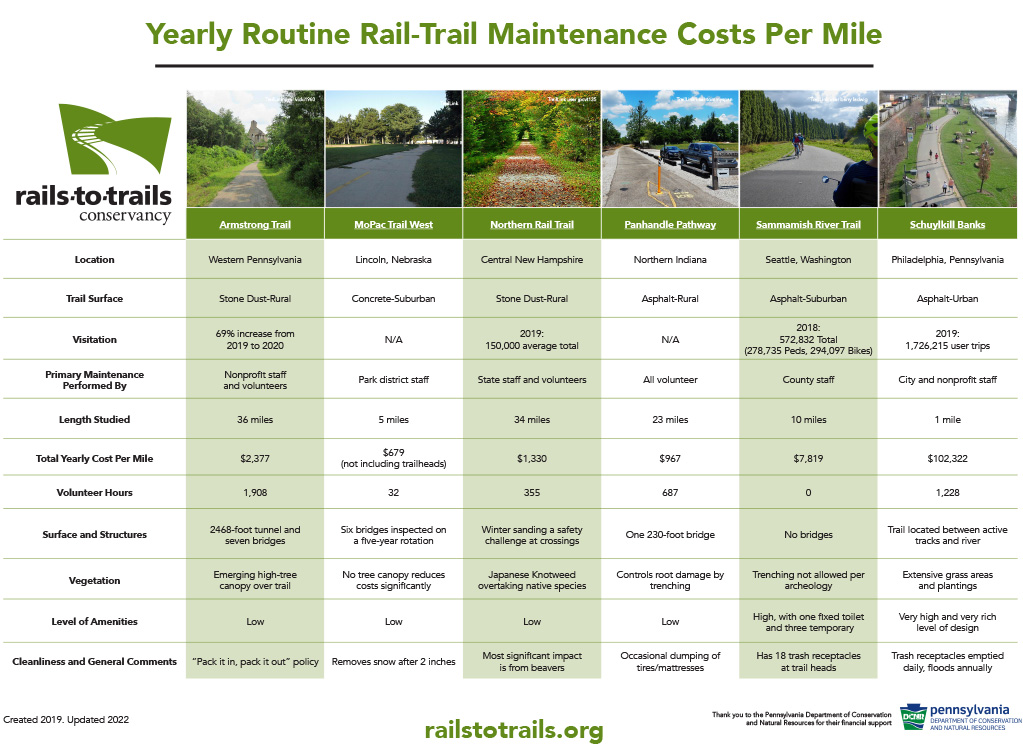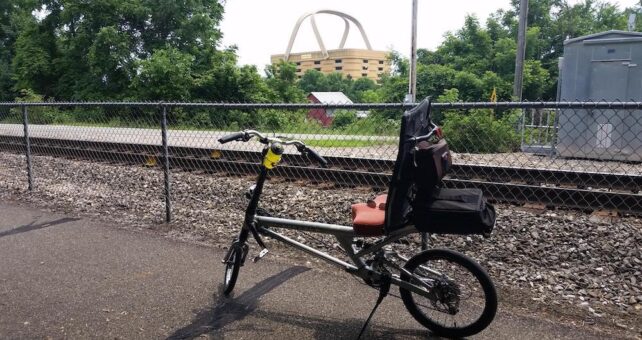Yearly Routine Rail-Trail Maintenance Costs Per Mile

The costs of rail-trail and multiuse trail maintenance are not well documented as a discipline—thus making it very difficult to compare practices for gaining cost savings and efficiencies. The purpose of this table is to quickly give a general sense of the routine maintenance cost per mile of various types of multiuse trails in different regions of the United States. With this information, the viewer can gain an understanding of the wide range of costs, help determine what a new project’s costs will be, or make some general comparisons to their existing trail.
This table is a continuation of Rails-to-Trails Conservancy’s (RTC’s) 2015 study, “Maintenance Practices and Costs of Rail-Trails,” which looked at 200 trails across the country. While very useful in determining standard maintenance tasks and their frequency, the 117-question study showed that trail maintenance costs are not readily available. The study also determined that even when they are available, they are not always easily understood and, therefore, not often helpful in determining the cost of new trail maintenance. Far too often, advocates don’t have good data when trying to make the case for trails.
Explanation of Table Components
The table represents the distilling of the study’s many questions into four broad, general categories: surface, vegetation, amenities and cleanliness. While trail elements are similar from one trail to another, trail managers have many various descriptions and methods for describing practices and costs. No one method is wrong, but the divergence in methodologies makes it difficult to meaningfully share them collectively among professionals. Even more of a challenge is the fact that one trail could have tasks performed by a number of cross-sector partners and groups—for example, a state entity, a contractor, a local municipality and a volunteer group. The trails portrayed here represent about one-third of those studied and are selected for their completeness, national representation and validity. The numbers shown here are a product of a peer-designed worksheet that captures essential maintenance-task costs. Other larger and more intricate templates were tested, after which we narrowed down the focus to those tasks deemed most important in the process, to ensure efficiency and ease of use.
Routine tasks are defined as occurring at least once a year. These can include frequently scheduled tasks such as mowing and trash dumping, or as-needed tasks like fallen-tree or graffiti removal. Routine costs as defined here do not include management, operations and programming, just hands-on work.
Capturing the costs of sporadic (or “periodic”) tasks is sometimes difficult and hard to differentiate from routine. Often, as budgets shrink, this list increases and can become deferred maintenance. This can result in the need to rebuild—potentially at many times over the original cost of the maintenance—and can impact the funding available for the construction of new trails. This dynamic needs to be studied more; for the purposes of this study, certain tasks, such as the cutting of tree roots, re-decking of bridges and inspection of bridges or tunnels, was included if they are part of a plan where specific sections of the trail have them performed on a yearly cycle or budgeted over many years.
Given the change in frequency of floods brought on by climate change, many trail managers now cite removal of debris and mud as routine, and those costs are included here.
Trail volunteers are essential to the maintenance and ultimate success of America’s trails. Without them, paid staff or contractors would need to be hired; thus, the value of volunteer hours has been quantified and is a part of the total cost shown here. The hours portrayed here are for just routine tasks as defined in the worksheet, not for one-time free labor to construct a kiosk, for example, or for trail patrolling, or for many other operational duties performed by trail volunteers across the country.
Now that rail-trails and other similar pathways are part of America’s mainstream infrastructure, RTC needs to build on this information and seeks comment and data-sharing in order to provide the trail community with better technical insight. This table is just the start of a more robust list of data points that can help inform maintenance costs and best practices for many types of trails, locations and other variables.
Thank you very much to those individuals that took the time to calculate these costs. If you are a trail manager and you would like to share your data with RTC, please contact Regional Director, Tom Sexton (tom@railstotrails.org). The more data we acquire, the faster we’ll get on the right track in supporting trail managers across the country with these critical maintenance issues.

Donate
Everyone deserves access to safe ways to walk, bike, and be active outdoors.

